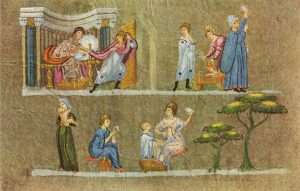The enduring mystique of the color purple is wrapped up in its creation, its control, its loss. The production of Tyrian purple vanished in the centuries after the fall of Constantinople in 1453—even if its visual connection with royalty and power persisted. In 1858, a French zoologist named Henri de Lacaze-Duthiers linked the substance oozing from a mollusk held by Spanish sailors to the purple mentioned by ancient writers such as Aristotle and Pliny. It wasn’t until 1903 that a synthetic Tyrian purple was produced. And while much scholarly discussion since then has addressed the ancient Greek and Roman history of purple, far less academic work has addressed its history in the middle and late Byzantine periods. Accomplished Byzantinist and art historian Chryssa Ranoutsaki fills this lacuna by reconstructing the visual grammar of Byzantine purple(s) in her new monograph, Purpur in Byzanz: Privileg und Würdeformel. This well-illustrated and engaging volume translates and parses the encrypted languages spoken through the hue over time, situating it firmly within the variant cultural, religious, imperial, and economic contexts at play within Byzantium over more than 1,100 years.
The book consists of a short introduction, four main chapters, a section of concluding remarks, an appendix with specialist terms in Greek and Latin, a list of translated primary sources commenting on the color purple, an extensive bibliography of secondary literature, and a catalogue of the manuscripts cited, many of which also illustrate the monograph. After an introduction to the reemergence, historiography, and reconstructions of Tyrian purple, Chapter 1 assembles a philological framework by laying out words and definitions. Ranoutsaki explicates all of the etymological aspects of the term “purple” and its citation in Greek and Roman literature, as well as its function in Greco-Roman mythology. This includes the Tyrian type, as well as other specialist terms for purple colors and fabrics. A table helpfully indicates various Greek and Latin terms with visual examples of the shades of purple to which they likely referred. A subsequent section explicates the exorbitant prices of purple dyes well into the fifteenth century. Their high value also led to a shadow economy for knock-offs and imitations. Citation of John of Damascus’ comment that people in purple dress were honored because wearing it made them look splendid and dignified provides a key context for understanding how the Romans of the Byzantine empire viewed the color—and why emperors often sought to control it.[1]
Chapter 2 examines purple goods in terms of Byzantine trade regulations and their use in diplomatic relations. Here, the long history of controlling the color comes to light, particularly as it pertains to the Theodosian Dynasty (379-457 CE). Legislation preserved in the Codex Theodosianus and the Codex Justinianus reveal the imperial focus on limiting the private production of authentic Tyrian purple at places such as Tyre and Sidon, curtailing the manufacture of imitation purple dye, and banning members of certain professions—such as sex workers and dancers—from donning purple garments. At this time, non-imperial persons seen in public wearing purple robes could be accused of sedition and even executed as usurpers.

Ranoutsaki debunks myths about absolute Byzantine monopolies on purple. She notes progressive regulations promulgated by Leo VI (886-912 CE) that allowed for private citizens to buy a small amount of purple fabric from imperial factories. A subsection on export bans of purple observes that the tenth-century Book of the Eparch cites five different shades of purple circulating in Constantinople—four of which were made in imperial factories—and notes the well-known ban on the sale of purple silks to foreigners. Byzantine enforcement of export regulations is glimpsed in other writings, such as the Relatio de legatione Constantinopolitana of Liutprand, the bishop of Cremona, which recounts events of the years 968-969. Ranoutsaki shows that for the imperial family, gifts of purple were an important part of the “diplomatic maintenance” (33) by the Byzantine court of its relationships with churches, dignitaries, and rulers, particularly in the western Mediterranean. When the crusaders sacked Constantinople during the Fourth Crusade (1204), they reveled in finally being able to send rarely-seen purple back home, as the donation list of the bishop Conrad of Krosigk to a German church in 1208 reveals.
Chapter 3 is the lengthiest, separated into two parts. The first localizes purple within the profane spaces and representations tied to the imperial house. The second looks at sacred, ecclesiastical contexts where purple was used. Ranoutsaki compares the visual depiction of Byzantine rulers and their subjects, then contrasts these secular portrayals with sacred depictions of Christ, the Virgin Mary, the archangels, and the martyrs. In examining how Byzantine emperors used purple, she connects its power to usage in ancient Egypt and among Persian royalty so as not to see Byzantine use in a vacuum. Although in this section there is a lot of leaping across time and space in the pre-Byzantine Mediterranean, the earlier non-Roman uses of purple are recognized as influential to later Byzantine usage. Sections on the use of the purple chlamys by dignitaries and those worn by the emperor and empress, as well as those visualized in depictions of clothing in mosaic, in manuscripts, and on porphyry statuary indicate purple clothing’s ubiquity when artists depicted the imperial family. Ranoutsaki shows that subtle changes in who could wear purple shoes underscore shifts between the early and middle Byzantine periods.

The representation of purple clothing in manuscript illuminations and other media is an important piece of Ranoutsaki’s evidence base. The role of the middle Byzantine imperial costume, the loros, is examined, as well as its use by monarchs outside Byzantium. Medieval Serbian favoring of Byzantine dress and Roger II of Sicily’s (r. 1130-1154) fashioning of himself as a Byzantine basileus, for instance, denote how the loros functioned outside the bounds of the Byzantine empire to signal power for other rulers. Additionally, a short section looks at the use and meaning of porphyry stone embedded in Byzantine buildings. In the eighth century, either Leo III or Constantine V established the Porphyra, a chamber in the imperial palace in Constantinople for empresses to birth children. It was lined in porphyry or purple curtains to give both a literal and figurative meaning for the newly coined title Πορφυρογέννητος (“born-in-the-purple”). Archaeological contexts gesture at imperial control of the stone, with elites able to purchase only small amounts for urns, ornamental vessels, or blazons. Emperors used this luxury, purple stone for monuments and for sarcophagi, but in the middle and later Byzantine periods there had to be much reuse since the quarries at the Mons Porphyrites in Egypt’s eastern desert appear to have closed in the late fourth century CE. Like purple clothing, use of porphyry by the papacy in building projects could signal imperial claims. The stone was inextricably linked to the right to rule.
Chapter 4 examines Byzantine textiles from late antiquity to 1453. Ranoutsaki demonstrates how both red (often dyed with kermes) and purple textiles were used for diplomacy and created connections between the Latin (Catholic) church and the Byzantine state, especially through gifts made of silk. Ranoutsaki does not merely record a list of diplomatic offerings to elites in the Islamic and Latin worlds, she also isolates moments of discernable change in the silk and dye industries as reflected in the types of gifts given. The eleventh and twelfth centuries witnessed a period of rapidly expanding demand for luxury fabrics and consequent attempts to find cheaper but still high-quality dyes for the expanding market. In April 1204, Constantinople was sacked by crusaders, and this pivotal center for silk and purple production was disrupted. Italian merchants and the rise of sericulture in western Europe are key to understanding how the Byzantine hold on the silk industry weakened.
Ranoutsaki offers perhaps too little analysis of purple’s disappearance by 1453 and thereafter. The ways in which painters, weavers, and other artists within and outside of Byzantium’s borders used purple to create a recursive grammar for meaning-making and power are essential to understanding the histories of color; however, the book only minimally addresses actual laborers and their status in society.
The language of color has been spoken for millennia, even if it has far fewer lexica than either Latin or Greek. Purpur in Byzanz is an important monograph that speaks to a moment where this is changing—both for researchers of the ancient Mediterranean and for those that study the Byzantine Empire. Ranoutsaki demonstrates that the early, middle, and late Byzantine eras are fruitful periods for understanding everything from monopolistic behaviors to the visualization of power and prestige. My one hope is that this book is soon translated from the original German, so that new groups of undergraduate students being taught Byzantine history will be able to use it more easily within a classroom context alongside its rich illustrations. In many ways, our students today cannot comprehend a world without access to all colors. The growth in synthetic and mass-produced dyes and pigments in the nineteenth and twentieth centuries has democratized color in a way that would have shocked the Byzantines, and it is this hierarchy, encoded in Byzantine color-culture, that Ranoutsaki so deftly rebuilds for her readers.
Notes
[1] John of Damascus, Oration on the Holy Icons, 1.36 (=PG, 94, Sp. 1264B).